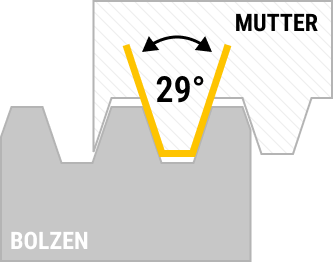
ACME trapezoidal thread (USA)
The ACME thread is the American version of the trapezoidal thread. It is used as a movement thread to transfer movements or move heavy loads. The ACME trapezoidal thread was developed back in 1894 and was intended to replace an older type of thread with a square profile. The trapezoidal shape not only proved to be more stable, but was also easier to manufacture and was therefore able to establish itself with ease. In addition to the normal ACME thread for general use, there is also another form with a reduced thread height, the STUB ACME. The dimensions of the ACME thread are defined in the ANSI/ASME B1.5-1977 standard.
The ACME thread is an imperial thread. All dimensions are given in inches and the pitch of the ACME thread is expressed in threads per inch. The ACME thread has a flank angle of 29°. It is mainly used in the USA, while in Europe the closely related form of trapezoidal thread with a flank angle of 30° is the standard.
The thread designation of the ACME thread consists of three parts. Firstly, the outside diameter is specified, followed by the pitch in threads per inch and the abbreviation ACME. An example of the thread designation of the ACME thread would therefore be 1/2″ - 10 ACME.
In the ACME thread table below, you will find the outer diameter with the original inch specification and the corresponding metric transmission. The pitch is also given both in threads per inch and mm. You will always need the core hole diameter if you want to cut an ACME thread yourself. We will be happy to produce dies or taps for the ACME thread for you on request.
